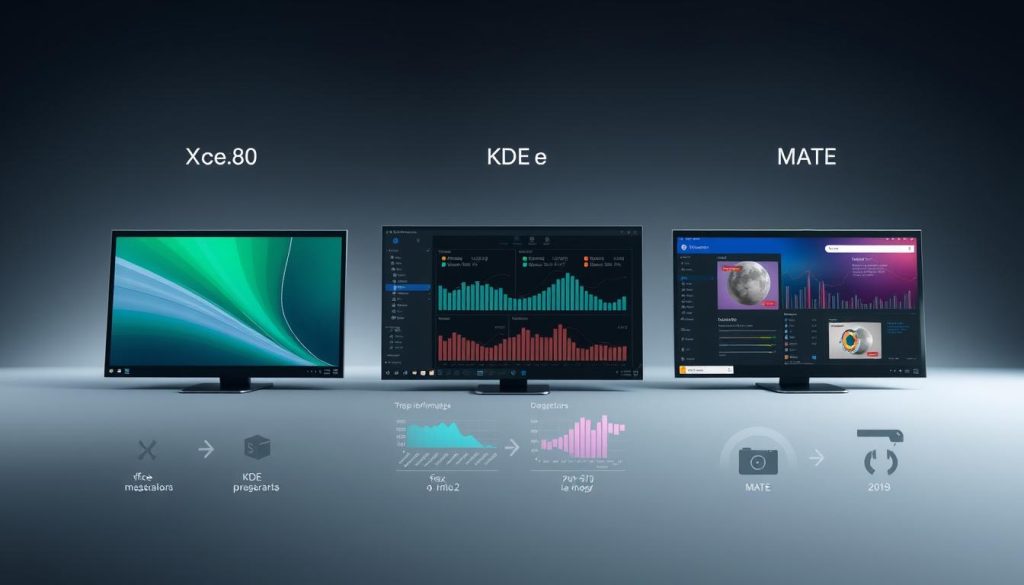Can a desktop operating system truly deliver a powerful, feature-rich experience without demanding the latest and most expensive hardware? This question lies at the heart of many users’ search for an efficient computing solution.- We introduce MX Linux, a prominent desktop operating system born from a unique collaboration. It combines the proven stability of Debian with core components from the antiX project. This partnership, symbolized by the “MX” name from MEPIS and antiX, results in a robust and reliable Linux distribution.
The design philosophy prioritizes a medium-weight approach. This balance offers solid performance on various machines while providing a complete and elegant desktop environment. It appeals to both newcomers and seasoned technology users seeking a stable, well-maintained system.
Our guide explores the principles that make this distribution a compelling choice. We will examine its commitment to accessibility, long-term support, and a conservative update cycle. These features ensure a dependable computing experience for everyday tasks and beyond.
Key Takeaways
- MX Linux is a collaborative desktop operating system based on Debian and antiX.
- It emphasizes stability, efficiency, and user-friendliness.
- The distribution follows a medium-weight design for balanced performance.
- It targets users seeking a reliable and well-supported system.
- The project maintains a conservative approach to updates for maximum reliability.
- Its origins acknowledge the contributions of the MEPIS and antiX communities.
Introduction to MX Linux
The quest for a dependable computing platform that performs consistently across various hardware configurations continues to drive innovation. We explore how one particular distribution addresses this need through a thoughtful combination of proven technologies.
This operating system represents a family of distributions built on a foundation of reliability and efficiency. The development team carefully balances modern features with conservative stability.
Defining the Distribution
MX Linux emerges as a Debian-based distribution that strategically merges the rock-solid stability of Debian Stable with innovative components from the antiX project. This unique combination results in a medium-weight system that delivers solid performance without excessive resource demands.
The distribution’s architecture emphasizes proven technologies over experimental features. This conservative approach ensures maximum reliability for daily computing tasks.
Overview of Its Purpose and Target Audience
This operating system serves users who prioritize reliability above cutting-edge capabilities. The target audience includes both newcomers to Linux and experienced users seeking a production-ready environment.
For those transitioning from other platforms, the distribution offers extensive pre-installed software and user-friendly tools. The system reduces the learning curve while maintaining professional-grade functionality.
Seasoned technology users appreciate the minimal maintenance requirements and consistent performance. The distribution’s conservative update cycle ensures stability across diverse hardware configurations.
History and Evolution of MX Linux
Behind every robust software platform lies a compelling history of partnerships and technical evolution. We trace this distribution’s journey from community discussions to its current status as a widely-adopted operating system.
MEPIS and antiX Community Roots
This platform originated in December 2013 when MEPIS community members explored future development paths. Their collaboration with antiX developers proved transformative over time.
The antiX team contributed sophisticated ISO build systems and live-boot technology. These components became foundational to the distribution’s identity and capabilities.
Key Milestones and Releases
Major version releases demonstrate steady progression. MX-14 “Symbiosis” established the core foundation based on Debian Wheezy.
Subsequent versions introduced significant enhancements. MX-15 “Fusion” moved to Debian Jessie while MX-16 “Metamorphosis” expanded the tool collection substantially.
The distribution maintained alignment with Debian Stable releases throughout its development. This strategy ensured compatibility across different hardware systems.
Recent versions like MX-23 “Libretto” and MX-25 “Infinity” represent maturation into one of the most popular Linux distributions. Extended support commitments now reach through 2030.
Deep Dive: what is mx linux
At the core of every reliable computing solution lies a carefully engineered system structure that balances modern capabilities with proven stability. We examine the technical foundation that enables this distribution to deliver consistent performance across diverse hardware environments.
Understanding the Operating System’s Core Structure
This platform builds upon Debian Stable 13 “Trixie” as its foundation. The integration of specialized antiX components enhances live-boot capabilities and overall system efficiency.
Kernel options include the standard Debian Linux kernel 6.12.48 for broad compatibility. Advanced Hardware Support editions feature the Liquorix 6.15 kernel for newer configurations.
The distribution offers flexible init system choices. Users can select between traditional SysVinit and modern systemd approaches.
Key architectural components include:
- APT package management for reliable software installation
- Support for both UEFI and MBR boot configurations
- Secure Boot compatibility for 64-bit UEFI installations
- Deb822 sources format implementation
This hybrid architecture maintains Debian’s renowned stability while incorporating antiX’s innovative live system technologies. The result is a robust desktop environment suitable for long-term deployment.
Extended support commitments ensure security updates through June 2030. This provides users with a stable computing platform for years to come.
MX Linux Features and MX Tools
Beyond a stable core, the true character of a distribution often reveals itself through the specialized applications it provides for system management. We now explore the comprehensive MX Tools suite, a collection of over 37 utilities that significantly enhance the user experience.
These graphical tools, now built on Qt6, are meticulously organized into functional categories. This structure simplifies complex tasks for users at any skill level.
Comprehensive Overview of MX Tools
The suite is divided into five logical groups. Each category addresses a specific area of system interaction.
- Live Tools: Handle creation of bootable media and system snapshots.
- Maintenance Tools: Offer system repair, configuration, and cleanup options.
- Setup Tools: Allow for deep personalization of the desktop environment.
- Software Tools: Manage packages, repositories, and updates efficiently.
- Utilities: Provide quick access to system information and operations.
This organization means you can find the right tool for any job without searching through menus. It streamlines administration remarkably.
Unique Functionalities like Live USB and Snapshot
Two features stand out for their power and innovation. The Live USB maker creates a fully functional portable desktop on a usb drive.
You can test the system or carry your workspace with you. Persistent storage keeps your changes safe between sessions.
The MX-snapshot tool is equally impressive. It remasters your entire setup into a single bootable iso file.
This snapshot captures all installed software and personal settings. It uses advanced antiX filesystem techniques for a perfect clone.
These functionalities, detailed in our complete guide, reduce command-line dependence. They make complex tasks accessible through a clear graphical interface.
System Requirements and Installation Process
The transition to a different computing environment begins with meeting system specifications and executing a smooth installation. We examine how this distribution accommodates diverse hardware while offering sophisticated installation features.
Minimum vs. Recommended Hardware Specifications
Basic functionality requires modest resources: 1 GB RAM and 8.5 GB disk space. These minimum specifications ensure operation on older machines.
For optimal performance, we recommend 2 GB RAM and 20 GB storage. Solid-state drives enhance responsiveness significantly.
Key hardware considerations include:
- Modern Intel or AMD processors for compatibility
- Bootable USB or DVD drive for media creation
- 3D-capable graphics for desktop effects
- Multi-core processors for efficient multitasking
Installation Process and Live Session Customizations
The graphical installer handles both UEFI and legacy BIOS computers effortlessly. It simplifies partition management and boot loader configuration.
A unique feature preserves live session customizations during installation. Users can test software and adjust settings before committing.
The installer includes innovative options like zram swap setup for limited-RAM systems. The “replace” feature streamlines switching from other distributions while preserving data.
Secure Boot support enables installation on modern hardware. This approach mirrors the flexibility seen in other systems like Proxmox virtualization platforms.
Typical installation completes in approximately four minutes. Snapshot releases incorporate updates to reduce post-install configuration time.
Desktop Editions and Performance
Choosing the right desktop environment represents a critical decision that directly impacts system performance and user experience across different hardware configurations. We examine how four distinct editions cater to diverse needs while maintaining the distribution’s core stability.
Comparison of Xfce, KDE Plasma, Fluxbox, and AHS
The default Xfce edition (version 4.20) delivers fast performance with medium-low resource usage. This balanced approach makes it suitable for a wide range of computers, offering both visual appeal and efficiency.
For users seeking advanced capabilities, the KDE Plasma edition provides a feature-rich desktop environment. Version 6.3.6 includes modern Wayland display server support with X11 fallback, catering to powerful hardware configurations.
The Fluxbox window manager edition represents the minimalist choice with very low resource usage. This lightweight option extends usability to older or resource-constrained systems while maintaining full functionality.
Advanced Hardware Support (AHS) edition specifically targets recent hardware with its Liquorix kernel and updated graphics drivers. This specialized version ensures compatibility with AMD Ryzen processors and latest Intel CPUs.
Boot times average approximately 14 seconds to login screen plus 4 seconds to desktop readiness. This consistent performance demonstrates efficiency across all editions despite varying resource demands.
User Experience and Community Support
Community engagement and support infrastructure play equally important roles alongside technical features in determining a distribution’s success. We examine how this platform balances immediate usability with long-term sustainability.
Advantages, Limitations, and Customization Options
The distribution offers significant benefits for various users. Its low hardware demands make it accessible to people with older computers.
Customization options abound through theme modifications and settings adjustments. The MX Tools suite provides a wide range of configuration possibilities.
Some users might find the conservative approach less exciting than cutting-edge distributions. The platform prioritizes stability over experimental features.
Community Resources and Official Documentation
Comprehensive support extends through June 2030 with security updates. Worldwide repository mirrors ensure reliable access to software packages.
The active forum facilitates knowledge exchange among users. Multiple package managers cater to different technical comfort levels:
- MX Package Installer for graphical software management
- Synaptic for traditional Debian package handling
- APT and Nala for command-line operations
Official documentation provides clear guidance for common tasks. This support system makes the platform accessible to newcomers while serving experienced users effectively.
Conclusion
Successful technology adoption often hinges on finding the right combination of stability, performance, and accessibility. Our examination reveals how this operating system effectively bridges the gap between cutting-edge capabilities and proven reliability.
The linux distribution builds upon Debian’s solid foundation with antiX components, creating a hybrid architecture that delivers exceptional stability. This system supports multiple boot options and systemd configurations, adapting to diverse hardware systems. With support extending through 2030, it represents a mature distribution suitable for long-term deployment.
Practical benefits include minimal resource usage, fast boot times, and comprehensive MX Tools that simplify administration. The default settings work well out-of-the-box, while advanced users can customize extensively. For those exploring alternative computing platforms, this linux distribution offers a compelling blend of enterprise-grade support and user-friendly design.
FAQ
How does this operating system handle systemd?
Can I test the software without installing it?
What file systems are supported during the installation process?
How does the package installer work?
What are the benefits of the snapshot tool?
Is it difficult to create a bootable USB drive?
How much disk space is recommended for a standard installation?
Where can I find help if I encounter issues?
Can I customize the desktop environment after installation?
How does resource usage compare to other Linux distributions?
Hi, I’m Mark, the author of Clever IT Solutions: Mastering Technology for Success. I am passionate about empowering individuals to navigate the ever-changing world of information technology. With years of experience in the industry, I have honed my skills and knowledge to share with you. At Clever IT Solutions, we are dedicated to teaching you how to tackle any IT challenge, helping you stay ahead in today’s digital world. From troubleshooting common issues to mastering complex technologies, I am here to guide you every step of the way. Join me on this journey as we unlock the secrets to IT success.



